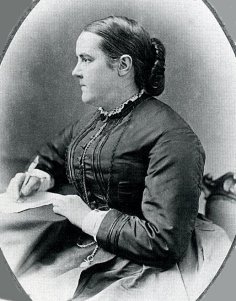Dr. SOPHIA JEX-BLAKE 1840 - 1912

Sophia Jex-Blake was a pioneer woman doctor. She did not practice in Brighton but lived as a young girl with her wealthy family at 13 Sussex Square Brighton. She was brilliant, energetic - and difficult and remained so all of her life. In fact she was removed from many local Girls Schools until eventually she went to study more successfully at The Queens College in London.
Here she met the Social reformer Octavia Hill, and Miss Elizabeth Garrett - who would later be the first woman to qualify as a doctor in the UK, although neither friendship prospered. Like many middle class women who were intelligent and active she searched for work to do and having travelled to the USA Sophia met Lucy Sewall who had qualified as a Doctor in Boston MA. The New England Female Medical College had been opened in 1856 and the New England Hospital for for Women and Children had opened in 1862. Sophia worked in the Hospital as an administrator but became convinced that she wanted to study medicine as her life’s work.
This she did, moving to Edinburgh in 1869 to attempt to study at the Medical School there with four other women , and a lengthy campaign followed since the University declined to admit women. Sophia made public speeches in defence of women students who were frequently abused in public; her feisty temper and autocratic manner often brought more enemies than friends and eventually she left Edinburgh defeated. The struggle continued and finally Sophia gained her MD in Berne in Switzerland in 1877. By this time the London School of Medicine for Women had been founded and the dramatic and strong-willed Sophia was deeply disappointed when her application for the prestigious post of Hon. Sec. was unsuccessful; the job going to the placid but determined Dr Elizabeth Garrett Anderson.
Deciding to return to Edinburgh and leaving her mother in Brighton Sophia leased a house at 4 Manor Place in Edinburgh and put up her brass plate. She opened a Dispensary at 73 Grove Street, Fountainbridge and stayed in Scotland in General Practice and as visiting physician to the Edinburgh Hospital for Women and Children until her retirement in 1899. She then moved back to Sussex into a cottage Windydene in the village of Mark Cross a few miles south of Tunbridge Wells. She died peacefully in 1912.